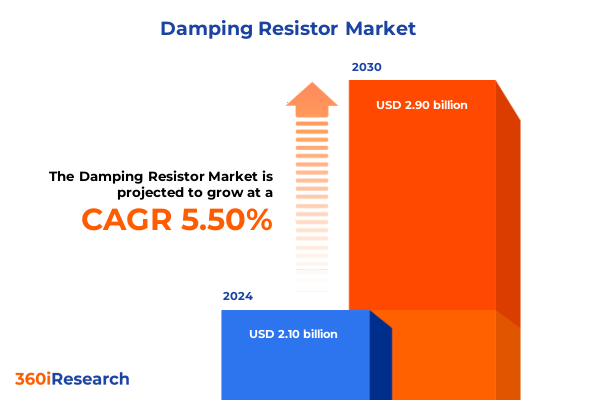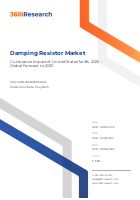The Damping Resistor Market size was estimated at USD 2.10 billion in 2024 and expected to reach USD 2.21 billion in 2025, at a CAGR 5.50% to reach USD 2.90 billion by 2030.

Introduction: Navigating the Damping Resistor Market in a Dynamic Environment
The damping resistor market operates at the intersection of precision engineering and dynamic performance demands. As industries push for lighter, faster, and more efficient systems, damping resistors have become critical components that mitigate unwanted vibrations, absorb mechanical shocks, and ensure signal stability across a broad spectrum of applications. From aerospace assemblies that require exacting vibration control to consumer electronics that demand compact and reliable performance, damping resistors serve as silent guardians against structural fatigue and performance degradation.
In today’s complex supply chains and tightening regulatory landscapes, manufacturers and design engineers need clarity on evolving material options, installation methodologies, resistance value selections, and end-use requirements. This executive summary distills the most important trends reshaping the damping resistor landscape, with a deliberate focus on emerging materials, shifting installation protocols, and cross-industry adoption curves. By unpacking these developments, we aim to equip decision-makers with actionable intelligence that bridges technical know-how and strategic foresight. Whether your mandate is product development, procurement optimization, or risk mitigation, this introduction sets the stage for a deeper exploration of market dynamics and strategic implications.
Transformative Shifts in the Damping Resistor Landscape
Over the past few years, the damping resistor landscape has undergone significant transformation driven by advances in materials science, miniaturization imperatives, and a wave of sustainability mandates. First, innovations in carbon film and metal oxides have yielded resistors with enhanced thermal stability and improved power density, enabling designers to reduce footprint without compromising reliability. Simultaneously, the rising popularity of surface mount installation has accelerated adoption in high-volume electronics, while through-hole variants retain their appeal for heavy industrial machinery where mechanical robustness is paramount.
Moreover, the convergence of digital twins and real-time simulation has shifted development cycles. Engineers are leveraging precise resistor models to predict system-level damping behavior, fostering a transition from reactive prototyping to proactive design optimization. This shift not only shortens time-to-market but also prunes costly late-stage modifications. Additionally, the push for greener electronics has intensified scrutiny of material sourcing and end-of-life scenarios, prompting suppliers to explore recyclable ceramic substrates and low-toxicity alloys.
Together, these transformative influences have redefined performance benchmarks, installation preferences, and lifecycle considerations for damping resistors across verticals.
Cumulative Impact of United States Tariffs 2025
In 2025, newly enacted United States tariffs on select resistor imports have introduced a layer of complexity for global supply chains. Components originating from regions with traditionally low manufacturing costs now carry additional duties, compelling procurement teams to reassess supplier portfolios and logistics strategies. While some manufacturers have absorbed the incremental costs to preserve price competitiveness, others are renegotiating contracts or exploring domestic partnerships to mitigate tariff exposure.
These measures have triggered a reallocation of production volumes, with certain metal film and wirewound resistor manufacturers accelerating capacity expansions within North America. Concurrently, businesses are intensifying cost-reduction initiatives through value-engineering efforts-revisiting resistance value ranges from up to 10 Ω through above 1 kΩ to identify specifications that balance performance with affordability. Suppliers are also reclassifying material categories-such as carbon film versus metal oxide-to qualify for duty exemptions or reduced tariff brackets.
Overall, the cumulative impact of these tariffs is reshaping sourcing decisions and prompting a gradual shift toward regionalized manufacturing networks that favor agility and supply-chain resilience.
Key Segmentation Insights Illuminating Diverse Market Niches
By examining segment nuances, a clearer picture emerges of where opportunities and challenges lie. Product-type differentiation between chip resistors, fixed resistors, variable resistors, and wirewound resistors reveals a dynamic interplay between miniaturization, power handling, and performance tolerance. Surface mount versus through-hole installation preferences highlight a design trade-off: compact assemblies require surface mount’s low profile, while high-vibration or high-power contexts still favor through-hole robustness. Resistance value range choices-from up to 10 Ω through bands of 10 Ω to 100 Ω, 100 Ω to 1 kΩ, and above 1 kΩ-drive specification strategies based on current flow, thermal considerations, and frequency response. Material-type insights draw attention to the distinct attributes of carbon film, ceramic, metal film, and metal oxide formulations, each presenting different cost, stability, and temperature coefficient profiles. Application-focused segmentation in acoustic damping, automotive shock absorption, industrial machinery, and vibration isolation underscores varying performance thresholds and regulatory requirements. End use industry segmentation spanning aerospace, automotive, consumer appliances, electronics, healthcare, and telecom signals diverse life-cycle demands, certification protocols, and volume patterns. Finally, sales-channel analysis juxtaposes offline distribution with the rapid ascent of online channels-where brand websites and e-commerce platforms influence lead times, after-sales service, and global reach.
This comprehensive research report categorizes the Damping Resistor market into clearly defined segments, providing a detailed analysis of emerging trends and precise revenue forecasts to support strategic decision-making.
- Product Type
- Installation Type
- Resistance Value Range
- Material Type
- Damping Application
- End Use Industry
- Sales Channel
Key Regional Insights Unveiling Geographical Dynamics
Regional dynamics are shaping both demand patterns and manufacturing footprints. In the Americas, strategic investments in local capacity expansions and innovation centers cater to aerospace and automotive OEMs demanding high-reliability components. Capitalizing on near-shore logistics, many suppliers are targeting quick-turn orders for prototyping and small batch production. Meanwhile, Europe, Middle East & Africa exhibits a strong emphasis on sustainability and regulatory compliance, with end users in healthcare and telecom driving the adoption of low-toxicity materials and eco-friendly end-of-life processes. Manufacturers in this region also benefit from well-established certification frameworks that facilitate cross-border trade. In Asia-Pacific, the market thrives on high-volume consumer electronics and cost-competitive manufacturing, encouraging surface mount dominance and aggressive price strategies. However, this growth also intensifies competition, prompting players to invest in product differentiation through advanced metal oxide compositions and automated quality-control systems.
This comprehensive research report examines key regions that drive the evolution of the Damping Resistor market, offering deep insights into regional trends, growth factors, and industry developments that are influencing market performance.
- Americas
- Asia-Pacific
- Europe, Middle East & Africa
Key Companies Driving Innovation and Growth
Industry leadership emerges from a mix of engineering prowess and strategic vision. ABB Ltd. has leveraged its global footprint to integrate damping resistors into broad power-distribution solutions, while Aktif Group focuses on bespoke resistor designs for industrial machinery. Eaton Corporation’s strategic acquisitions have enhanced its materials portfolio, enabling unique ceramic and metal film offerings. Elecos Engineers Pvt. Ltd. and GINO AG both drive innovation in wirewound resistor configurations tailored for high-power applications. Hi Tech Resistors Pvt. Ltd. and HI-VOLT TEKNO Products have carved niches in specialized damping applications, collaborating closely with automotive OEMs. Mira Enterprises and REO AG underscore the importance of agility, delivering rapid prototyping and regional distribution models. RST ELECTRICALS PVT LTD emphasizes quality certifications, ensuring compliance with rigorous industry standards. At the same time, Schneider Electric SE and Siemens AG harness system-level integration, embedding resistors into smart grid and automation platforms. TDK Corporation and Toshiba Industrial Products and Systems continue to push performance limits with advanced material science, and YueQing JSM Transformer Co. focuses on synergistic product bundles that complement transformer and resistor assemblies.
This comprehensive research report delivers an in-depth overview of the principal market players in the Damping Resistor market, evaluating their market share, strategic initiatives, and competitive positioning to illuminate the factors shaping the competitive landscape.
- ABB Ltd.
- Aktif Group
- Eaton Corporation
- Elecos Engineers Pvt. Ltd.
- GINO AG
- Hi Tech Resistors Pvt. Ltd.
- HI-VOLT TEKNO Products
- Mira Enterprises
- REO AG
- RST ELECTRICALS PVT LTD
- Schneider Electric SE
- Siemens AG
- TDK Corporation
- Toshiba Industrial Products and Systems
- YueQing JSM Transformer Co.
Actionable Recommendations for Industry Leaders
As the damping resistor landscape evolves, industry leaders must adopt proactive strategies. First, diversifying material sourcing by qualifying alternative carbon film and metal oxide suppliers can reduce dependency on high-tariff regions and ensure uninterrupted production. Second, investing in advanced simulation tools and digital-twin capabilities will accelerate design validation and minimize costly late-stage revisions. Third, enhancing regional manufacturing agility through modular production lines and flexible capacity agreements can respond to shifting end-use demands driven by aerospace, healthcare, and telecom sectors. Fourth, forging closer partnerships with distribution channels-both offline and online-will expand market reach, shorten lead times, and improve post-sales support. Finally, embracing sustainability by optimizing end-of-life recyclability and low-toxicity material profiles will align product roadmaps with stricter environmental regulations and end-user expectations.
Explore AI-driven insights for the Damping Resistor market with ResearchAI on our online platform, providing deeper, data-backed market analysis.
Ask ResearchAI anything
World's First Innovative Al for Market Research
Conclusion: Harnessing Resilience and Innovation for Future Success
In summary, the damping resistor market presents a tapestry of technical intricacies and strategic inflection points. The convergence of novel materials, evolving installation preferences, and regulatory forces underscores the need for agility and foresight. As tariffs reshape global sourcing and regional players invest in local capacity, competitive advantage will hinge on the ability to balance performance, cost, and compliance. Segmentation insights reveal that tailored resistor constructions-whether chip, fixed, variable, or wirewound-must align precisely with installation, resistance range, and damping application requirements. Regional dynamics underscore the importance of proximity to end users and adherence to jurisdictional standards. Leading companies exemplify how integrated solutions, material innovation, and customer-centric partnerships can drive differentiation.
By absorbing these strategic takeaways, organizations can refine their product portfolios, optimize supply chains, and reinforce their position in a market characterized by rigorous performance demands and dynamic regulatory landscapes.
This section provides a structured overview of the report, outlining key chapters and topics covered for easy reference in our Damping Resistor market comprehensive research report.
- Preface
- Research Methodology
- Executive Summary
- Market Overview
- Market Dynamics
- Market Insights
- Cumulative Impact of United States Tariffs 2025
- Damping Resistor Market, by Product Type
- Damping Resistor Market, by Installation Type
- Damping Resistor Market, by Resistance Value Range
- Damping Resistor Market, by Material Type
- Damping Resistor Market, by Damping Application
- Damping Resistor Market, by End Use Industry
- Damping Resistor Market, by Sales Channel
- Americas Damping Resistor Market
- Asia-Pacific Damping Resistor Market
- Europe, Middle East & Africa Damping Resistor Market
- Competitive Landscape
- ResearchAI
- ResearchStatistics
- ResearchContacts
- ResearchArticles
- Appendix
- List of Figures [Total: 30]
- List of Tables [Total: 375 ]
Call-To-Action: Connect with Ketan Rohom to Unlock In-Depth Market Intelligence
To gain comprehensive insights and detailed analysis on these critical market developments, reach out to Ketan Rohom (Associate Director, Sales & Marketing) today. Discover how in-depth research can empower your strategic decisions, strengthen supply-chain resilience, and identify untapped growth opportunities in the damping resistor landscape. Secure your access to expert guidance and actionable intelligence by connecting directly with Ketan Rohom and elevate your competitive edge.

- How big is the Damping Resistor Market?
- What is the Damping Resistor Market growth?
- When do I get the report?
- In what format does this report get delivered to me?
- How long has 360iResearch been around?
- What if I have a question about your reports?
- Can I share this report with my team?
- Can I use your research in my presentation?




